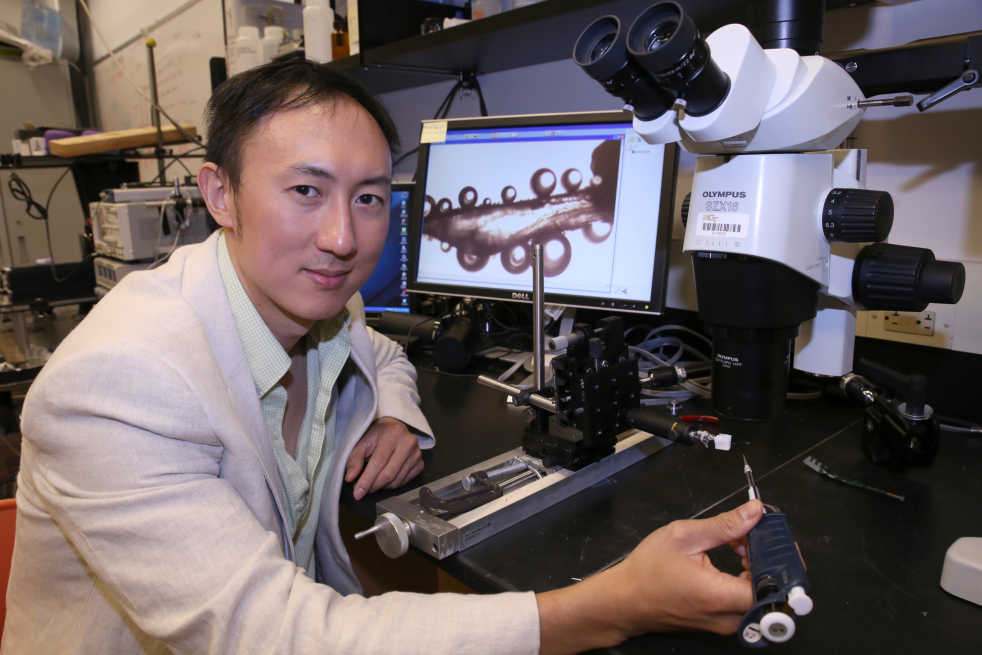Engineering and Biology and Adjunct Associate Professor of Physics at Tech, David Hu originally intended to pursue a career in the field of creative writing after he graduated from MIT, but instead ended up earning a Ph.D. in mechanical engineering.
Like many undergraduate students, Hu was unsure where his passions would lead him in his career.
“I don’t think people are willing to admit that basically at 22, people don’t know what they want to do,” said Hu. “Even at 37, I still don’t know exactly what I want to do. I just know that I really like working with the students, and I like making discoveries and I do like telling people about the discoveries.”
Originally a pre-med student, Hu invested himself in that route working as an EMT and at a phone student counseling service. However, he found that biology on a microscale wasn’t that intriguing to him. He found that studying microscopic subjects had limitations where his current research did not. Studying animals and insects allowed him to use high-speed cameras for analysis and ignore small intramolecular forces.
Like his career path, Hu’s work is very interdisciplinary in nature, an amalgam of the fields of engineering, biology and robotics. As a leading researcher in the field of biomechanics of animal locomotion, he works with a range of animals including frogs, elephants, dogs and different insects.
“Nature has been around for a while; it requires tools from everybody,” said Hu. His undergraduate advisor was also interdisciplinary, and his first major foray in biolocomotion began as a homework assignment. His project studied how water striders moved and he discovered that the insects do not walk but instead they row on water. That homework assignment blew up in fame and attracted the attention of big media outlets such as The New York Times and NPR.
“Since then, my work has been featured almost yearly on The Times,” said Hu. “Discovery Channel comes by once or twice a year.” The “Van Gogh”-esque photograph he took of the water strider on food coloring-dyed water has been featured on the cover of the Fluid Mechanics textbook used at Georgia Tech since he first started as faculty.
Hu believes that scientists have a duty to pursue the truth. Hu takes finding the truth a step further by spreading the truth using a concept he calls “science communication.” This is the concept of presenting scientific topics to the public. “I like figuring out how people think and working with students. I do care if people understand the science.”
Since his project, Dr. Hu has been featured on a plethora of other media platforms and his work has earned numerous accolades over the years, some unconventional such as the Ig Nobel prize and the Pineapple Science Award, which claims to “honor achievements that first make people laugh, and then make them think.” Hu notes, “My projects usually start out as a fun question.”
He has not only been published in high-impact scientific journals such as Nature, but he has also written for Physics Today and American Scientist. Although Hu’s creative writing career is on the backburner, he is still producing content that reaches huge audiences.
“I think it’s nice to have the scientific stuff,” said Hu. “I think I’m a good non-fiction writer — I wasn’t good with coming up with characters and a whole world.”
Hu took his science communication or “sci-com” skills further than the written word and has appeared on numerous television shows ranging from The Discovery Channel to a Chinese game show where he was the only scientist to compete.
In addition, after learning Chinese by taking classes at Tech, Hu gave a televised five-minute presentation completely in Chinese. He currently has a book about animal movement for Princeton in the works which is expected to be published in 2018 and an interview with another Ig Nobel Prize recipient that is due to be aired on national Argentinian television.
Science communication has a dark side in today’s society, however. Just last year, Hu and a trove of other scientists were cited in Arizona senator Jeff Blake’s yearly list of wasteful scientific studies. Hu asserts that “it’s terrorism on scientists,” because negative publication like this can ruin a scientist. In fact, he knows of budding scientists whose careers were ruined by this publication. “Science communicators are not seen as real scientists,” said Hu. “We spend our whole lives trying to show the truth, and sci-com is not about showing the truth, it’s just about showing how cool [science] is and getting people really interested.”
Currently, Hu hopes to establish a science communication class at Georgia Tech, so he can encourage other budding scientists to not only discover the truth, but also to wield it as a tool to educate others.
